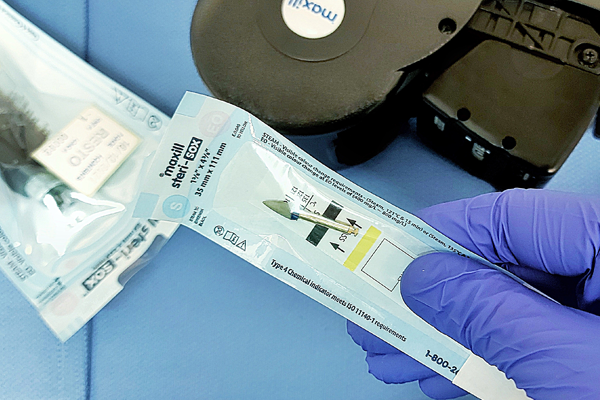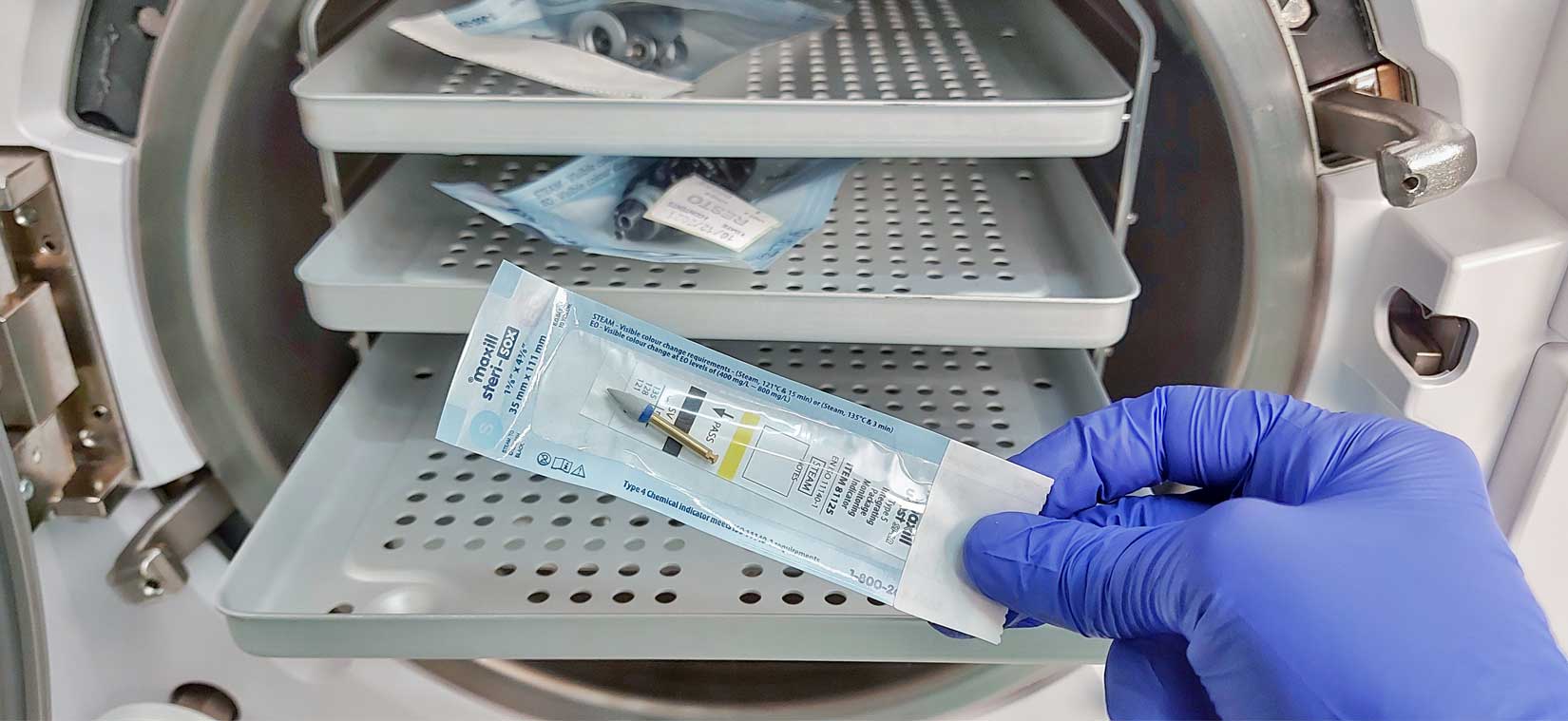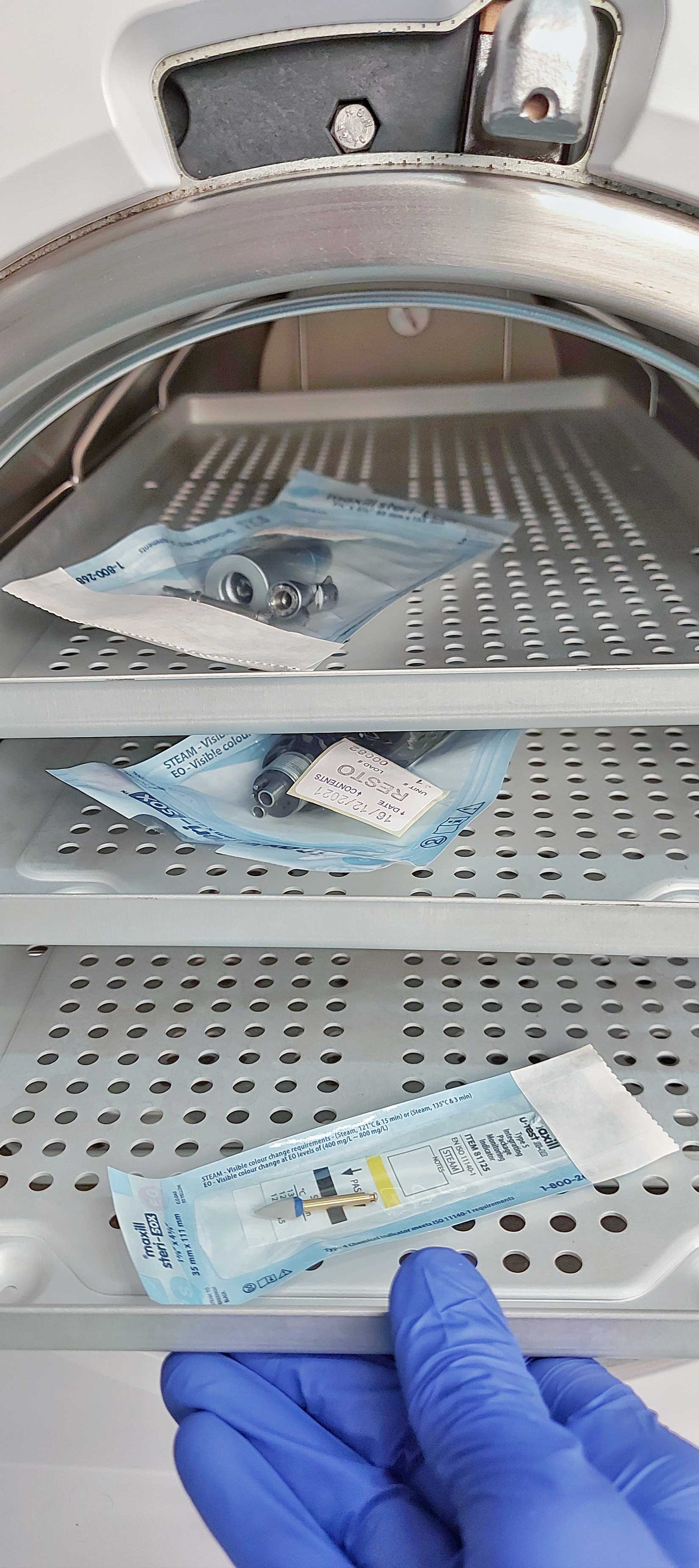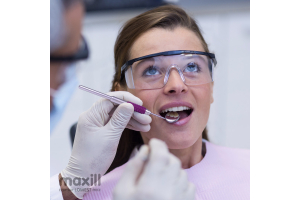Step-by-Step Guide to Reprocessing Dental Handpieces and Burs: Protecting your Patients and Investment

The cost of operating a dental office is staggering, and one sizeable investment is in dental handpieces.
Choosing and investing in quality dental burs and handpieces increases productivity, reliability and reduces chair time for patients, making dental treatment less stressful.
Handpieces are compressed-air driven, use newer electric technology, or are battery-powered, as in cordless prophy handpieces.
Proper maintenance and sterilization practices provide years of service and guarantee patient safety.
Where Does Contamination Happen?
Disease transmission studies show that the internal components of air-driven dental handpieces (both low-speed and high-speed devices) and dental burs can become contaminated with patient saliva, blood, and tissue during use.
This material can then be expelled into the mouth of other patients during subsequent uses.1,2
Contamination of low-speed handpieces with prophy angles can occur inside the nosecone, motor, and prophy angles.3
To break the chain of disease transmission, thorough dental handpiece reprocessing and proper cleaning and sterilization of burs must occur by trained dental personnel.
The Centers for Disease Control (CDC) and the Food and Drug Administration have specific guidelines that address dental handpiece reprocessing to train our dental team.
"CDC recognizes that the dental community requires clear, consistent guidelines on the best way to reprocess dental handpiece devices between patient encounters.
CDC guidelines for infection prevention and control state that, between patients, dental health care personnel (DHCP) should clean and heat-sterilize handpieces and other intraoral instruments that can be removed from the air and waterlines of dental units.4"
Step-by-Step Guide to Reprocessing Dental Handpieces and Burs
How To Reprocess Dental Handpieces
In 2015 the Food and Drug Administration (FDA) released updated guidance for reprocessing medical devices in a health care setting.5
The FDA regulates dental handpieces as medical devices and as such dental handpiece sterilization methods are included in the updated guidance.
The FDA gave dental manufacturers recommendations on how to write reprocessing instructions for their equipment based on current evidence-based information.
Before 2015, not all dental handpieces included manufacturers' instructions for use that met the latest FDA guidelines, and most handpieces were not able to be heat sterilized.
Simply, if the FDA does not clear a dental handpiece, it is not supplied with specific manufacturer's instructions for use, and the handpiece cannot be heat sterilized, dental personnel should not use the device for patient care.
In general there 4 steps for dental handpiece sterilization.
The Four Steps in Appropriate Reprocessing of Dental Handpieces:
- Clean and Disinfect the Exterior
After removing the bur, clean and disinfect the outside of the handpiece and attachments with a disinfectant spray or wipes to remove the bioburden; use a soft brush if necessary. TB Minuteman NEX GEN is an EPA-registered, intermediate-level disinfectant that meets the CDC recommendations and is ideal for use in dental offices. Do not submerge the handpiece in chemical solutions or ultrasonic cleaner. - Lubricate the Internal Components
It is best practice to follow the manufacturer's instructions for use that recommends lubricants and lubricating processes for your specific handpiece. For our stel line of low-speed handpieces, we recommend lubricating with spray lubricant after each use and/or before autoclaving. - Sterilize
Remove nose cones, contra-angles, and latch heads from the handpiece motor. Wipe all residual oil from handpiece components before placing them in separate sterilization pouches for sterilization. Remove burs before sterilization as failure to remove them may result in damage and corrosive reactions between different metals. Again, best practice is to follow manufacturers' instructions for use for appropriate sterilization directions. - Check, Dry, Cool, and Store
Check autoclave package internal or external color change indicators to ensure proper sterilization was reached. Allow package to thoroughly dry and cool before storage and use.
Hands-free handpiece maintenance systems are also available, designed to quickly and efficiently clean, lubricate, and purge your instruments.

How to Reprocess Dental Burs
Dental burs should be treated with care, disinfected, and sterilized to maintain cutting efficiency while preventing cross-contamination.
Studies have shown that effective decontamination methods, including proper cleaning and autoclave sterilization, reduced bacteria on dental burs to undetectable levels.
It is important to note that single-use burs must be sterilized before use unless marked as sterile.
There is a wide selection of dental burs, each with distinctive benefits. Diamond and carbide are the most commonly used.
They can be single-use or multi-use.
maxill is excited to introduce a new lineup of premium quality dental burs, diamonds and polishers. Ohio Forge Burs deliver top-quality performance at a price you’ll love.
The Three Steps in Appropriate Reprocessing of Dental Burs:
- Clean and Disinfect the Exterior
- Ultrasonic Cleaning: After removing the bur from the dental handpiece, place the bur securely in the bur guard. The Zirc Bur Guard protects the burs from damage during ultrasonic cleaning and sterilization. Place the bur guard in an ultrasonic cleaner with an enzymatic solution that is non-corrosive and powerful enough to remove the dried blood, protein, and mucin deposits from complex and detailed bur heads. We recommend our UCS33 Ultrasonic Cleaning Solution. It is recommended to run a 10-minute cycle followed by a 2-minute cold water rinse.
- Manual Cleaning: If there is no ultrasonic cleaner available, debris can be cleaned off of burs manually as well. To start, presoak burs in an ultrasonic cleaner for a minimum of 5 minutes. We recommend our UCS33 Ultrasonic Cleaning Solution. Then gently scrub away any remaining debris. Finish by rinsing the burs for 2 minutes followed by drying with a lint-free towel.
NOTE: burs must be free of contaminated debris before sterilization; follow your ultrasonic cleaning solutions and device instructions for use to ensure proper cleaning.
- Sterilize
- Burs may be sterilized by using a dynamic air removal sterilization cycle. Sterilize in an FDA-approved pouch at full cycle with a dwell at 132ºC / 270ºF minimum for 3 minutes. We recommend sterilizing in our steri-sox self-sealing sterilization pouches. They are available in the 1.375" x 4.375" sized pouches, the perfect size for dental burs.
- Check, Dry, Cool, and Store
- Check autoclave package internal or external color change indicators to ensure proper sterilization was reached. Allow package to thoroughly dry and cool before storage and use.

You have chosen to purchase quality handpieces and burs for your office; proper maintenance and sterilization protocol will ensure the handpiece and burs give back reliable, safe, and efficient service.
References
- Chin JR, Miller CH, Palenik CJ. Internal contamination of air-driven low-speed handpieces and attached prophy angles. J Am Dent Assoc. 2006;137:1275–1280
- Herd S, Chin J, Palenik CJ, Ofner S. The in vivo contamination of air-driven low-speed handpieces with prophylaxis angles. J Am Dent Assoc. 2007;138:1360–1365
- Herd S, Chin J, Palenik CJ, Ofner S, The in vivo contamination of air-driven low-speed handpieces with prophylaxis angles. J Am Dent Assoc. 2007
- Centers for Disease Control and Prevention. Guidelines for infection control in dental health-care settings—2003.MMWR Recomm Rep. 2003;52(RR-17):1–61
- US Food and Drug Administration. Reprocessing Medical Devices in Health Care Settings: Validation Methods and Labeling. Guidance for Industry and Food and Drug Administration Staff Silver Spring, MD: US Food and Drug Administration, US Dept of Health and Human Services; 2015
- Mathivanan, A., Saisadan, D., Manimaran, P., Kumar, C. D., Sasikala, K., & Kattack, A. (2017). Evaluation of Efficiency of Different Decontamination Methods of Dental Burs: An In vivo Study. Journal of pharmacy & bioallied sciences, 9(Suppl 1), S37–S40. https://doi.org/10.4103/jpbs.JPBS_81_17












